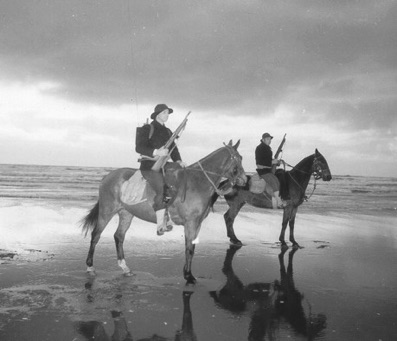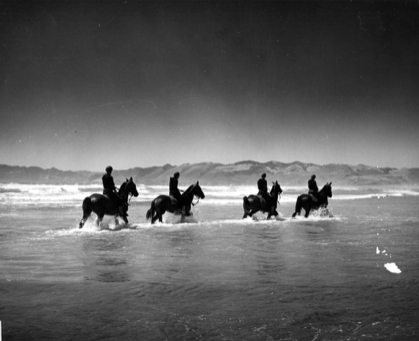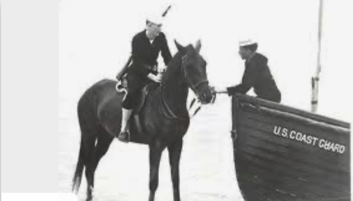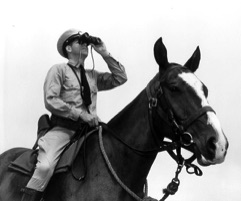Mounted Patrols in WWII
In January 1942 German U-boats were sent to the Atlantic as part of Operation Drumbeat to hunt for and sink as many merchant vessels as possible. These merchant vessels carried oil and supplies for the Allies in Europe. By sinking them, Germany hoped to weaken the war effort. For six months, they rampaged up and down the coast. In addition to the danger for shipping, it was thought that these subs might carry out sabotage and espionage missions by sending small groups ashore.
After the attack on Pearl Harbor in 1941, the Coast Guard established the wartime beach patrol and it became active in early 1942. The Life-Saving Service , a forerunner of the Coast Guard, used horses to haul boats from sheds to the water for launching, however they conducted patrols on foot.
The Coast Guard put out the call for for men who could ride and a wide range of cowboys, polo players, rodeo riders, horse trainers and others enlisted. Training took place at Elkins Park Training Station in Pennsylvania and at Hilton Head where the Dog Training Center was already operating. Horses came from the Army and riding gear was provided by the Army Remount Service. The patrol uniforms were provided by the Coast Guard. The mounted patrol eventually had 3,000 horses. Apparently not everyone who enlisted was a seasoned rider. A letter sent home by Jack Hubbard of Cumberland County recounted that "Many had never ridden anything but a hobby-horse. During training there were men so saddle sore they stood to eat their meals. Those horses from the U.S. Cavalry knew every trick in the book."
The mission of the mounted patrol was to look out for enemy ships, report and/or prevent enemy landings, and stop communications between ships and enemy agents on shore. Although we cannot find documentation of this event, local families have passed down the story of an incident along the Intracoastal Waterway. An alleged Nazi sympathizer was arrested after a radio was discovered in his attic. In Florida and New York two teams of saboteurs were captured after being sent ashore from U-boats. The establishment of the patrols also provided reassurance to citizens that there was a force on guard to protect against invasion and sabotage.
Patrols usually consisted of two men on horseback, sometimes accompanied by a trained dog wearing canvas booties to protect its feet from oyster shells. Mid-Atlantic beaches were especially good for the work of these patrols because of the wide view available. New England beaches with their rocky coasts and cold winters were unsuitable for the horses. Other areas were not used because of logisitical difficulties in accessing food and water, especially for the horses. The use of horses allowed riders to more easily carry radios, rifles and other equipment.
By 1944 concern about enemy invasions had decreased and air plane detection of submarine warfare had improved with the introduction of radar. The mounted patrols were disbanded and many of the horses were sold at public auction. A report from 1945 highlights the importance of the mounted patrols and the dedicated service of its members.
"Despite the many difficulties encountered and overcome, the morale of the men was universally high...Where horses and dogs were used, consideration of the animals was often more important than the comfort of the men. Upon them, as much as upon the welfare of the handlers, depended the sustained vigilance of the patrol. [They] stood as a constant reminder that the military duties on the home front are often as essential to victory as the more exciting activities to the far-flung battle line."
To see the mounted patrols in action, click here for newsreel from that era.
Comments or suggestions? Email us
Sources
Brunswick County Historical Society, February 2000 Newsletter
USCG Historians Office
USCG Compass
Horse-Canada: Horses and History



